Harbor Freight Tools 93793 User Manual
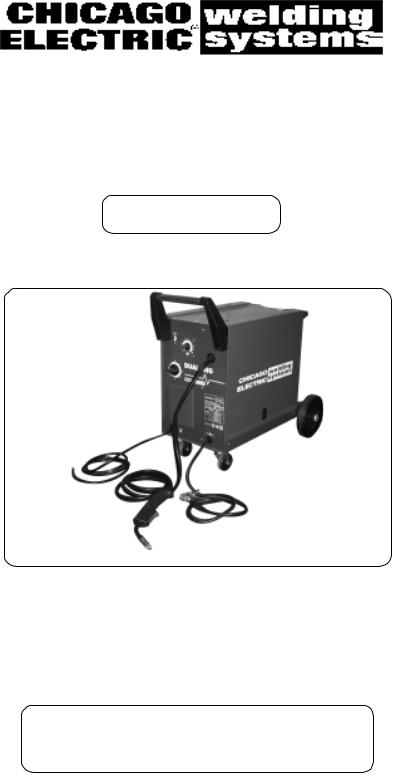
DUAL MIG
WELDER
Model 93793
ASSEMBLY AND OPERATING INSTRUCTIONS
Due to continuing improvements, actual product may differ slightly from the product described herein.
Distributed exclusively by
Harbor Freight Tools®.
3491 Mission Oaks Blvd., Camarillo, CA 93011
Visit our Web site at: http://www.harborfreight.com
TO PREVENT SERIOUS INJURY,
READ AND UNDERSTAND ALL WARNINGS
AND INSTRUCTIONS BEFORE USE.
Copyright© 2006 by Harbor Freight Tools®. All rights reserved. No portion of this manual or any artwork contained herein may be reproduced in any shape or form without the express written consent of Harbor Freight Tools.
For technical questions, please call 1-800-444-3353.
Contents |
|
PRODUCT SPECIFICATIONS .......................................................... |
3 |
GENERAL SAFETY RULES ............................................................. |
3 |
Specific Safety Rules ................................................................................... |
6 |
Grounding..................................................................................................... |
9 |
Extension Cords .......................................................................................... |
10 |
Symbology ................................................................................................... |
10 |
UNPACKING .................................................................................... |
10 |
ASSEMBLY INSTRUCTIONS .......................................................... |
11 |
To AttachThe Handle .................................................................................. |
11 |
To InstallThe Rear Wheels And Casters .................................................... |
11 |
To Install a 2 lb. Wire Spool ........................................................................ |
12 |
To Install a 10 lb.Wire Spool ...................................................................... |
12 |
To RouteThe Wire ....................................................................................... |
13 |
To ChangeWire Settings ............................................................................ |
15 |
SettingThe Gun Polarity For WireType ..................................................... |
16 |
To AttachThe Ground Cable With Clamp................................................... |
16 |
To Install A Gas Cylinder ............................................................................ |
17 |
OPERATING INSTRUCTIONS ........................................................ |
18 |
BeforeYou BeginWelding ........................................................................... |
18 |
Duty Cycle (Duration of Use) ...................................................................... |
18 |
Setting UpThe Weld .................................................................................... |
19 |
HoldingTheWeldingTorch ......................................................................... |
20 |
Weld Settings Chart .................................................................................... |
21 |
Weld Diagnosis............................................................................................ |
23 |
When the Weld is Completed ...................................................................... |
25 |
INSPECTION, MAINTENANCE, AND CLEANING .......................... |
26 |
Nozzle Inspection, Cleaning, and Replacement ......................................... |
26 |
ContactTip Inspection, Cleaning, And Replacement................................. |
26 |
ReplacingTheWeldingTorch Liner ............................................................ |
27 |
Parts Lists and Diagrams .............................................................. |
28 |
Wiring Schematic ........................................................................................ |
28 |
Parts List ..................................................................................................... |
29 |
Assembly Diagram ...................................................................................... |
30 |
TROUBLESHOOTING ..................................................................... |
32 |
WARRANTY ..................................................................................... |
34 |
SKU 93793 |
For technical questions, please call 1-800-444-3353; |
Page 2 |
|
Troubleshooting section at end of manual. |
|||
|
|
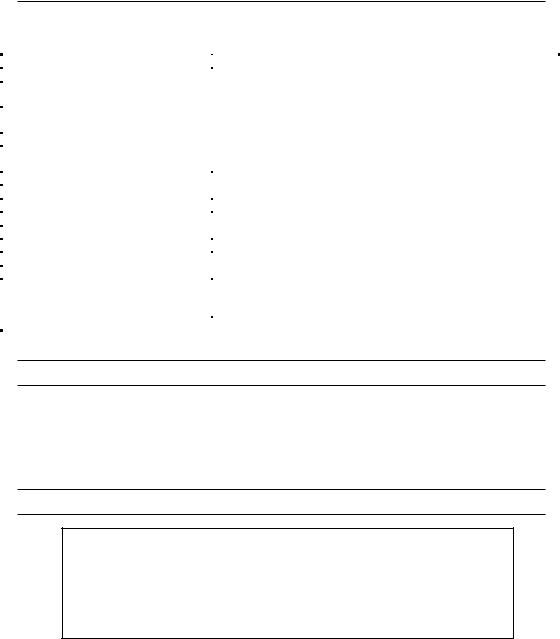
|
PRODUCT SPECIFICATIONS |
|
|
|
|
|
|
|
Item |
Description |
|
Welding Current |
35 ~ 140 Amps |
|
|
Duty Cycle |
18% @ 140 Amps / 100% @ 45 Amps |
|
|
|
|
(Refer to chart and explanation on page 18) |
|
Power Consumption |
230 Volt / 60 Hz / Single Phase / 25 Amps |
|
|
|
|
(Should be connected to a 25 Amp minimum dedicated circuit) |
|
Open Voltage |
15.5 - 20 Volts |
|
|
Required Power Plug Type |
3-Prong, 220 VAC, polarized, twist lock (not included) |
|
|
|
|
NEMA #L6-30 or equivalent |
|
Power Cord Rating |
12 AWG x 3C x 6’ Long |
|
|
Gas Inlet Size |
1/4” |
|
|
Ground Cable |
4 Gauge / 6’ Long |
|
|
Torch Power Cable |
8 Gauge / 6’ Long |
|
|
Thermal Overload Protection (with Light) |
Automatic shutdown and restart after cool down |
|
|
Wire Size |
0.23” to 0.035” |
|
|
Wire Spool Size |
7-3/4” Diameter |
|
|
Included Torch Tip Size |
0.030” |
|
|
Accessories |
Wheel Kit / Wire Spool / Torch Assy. / Grounding Clamp |
|
|
|
|
Wire Brush & Hammer / Spare 1.0 & 0.8 Welding Tips |
|
|
|
Hand-Held Face Shield |
|
Net Weight |
103 Pounds |
|
|
SAVETHIS MANUAL
You will need this manual for the safety warnings and precautions, assembly, operating, inspection, maintenance and cleaning procedures, parts list and assembly diagram. Keep your invoice with this manual. Write the invoice number on the inside of the front cover. Keep this manual and invoice in a safe and dry place for future reference.
GENERAL SAFETY RULES
 WARNING!
WARNING!
READ AND UNDERSTAND ALL INSTRUCTIONS Failure to follow all instructions listed below may result in electric shock, fire, and/or serious injury.
SAVE THESE INSTRUCTIONS
WORK AREA
1.Keep your work area clean and well lit. Cluttered benches and dark areas invite accidents.
2.Do not operate power tools in explosive atmospheres, such as in the presence of flammable liquids, gases, or dust. Power tools create sparks which may ignite the dust or fumes.
3.Keep bystanders, children, and visitors away while operating a power tool.
Distractions can cause you to lose control. Protect others in the work area from debris such as chips and sparks. Provide barriers or shields as needed.
SKU 93793 |
For technical questions, please call 1-800-444-3353; |
Page 3 |
|
Troubleshooting section at end of manual. |
|||
|
|
ELECTRICAL SAFETY
4.Grounded tools must be plugged into an outlet properly installed and grounded in accordance with all codes and ordinances. Never remove the grounding prong or modify the plug in any way. Do not use any adapter plugs. Check with a qualified electrician if you are in doubt as to whether the outlet is properly grounded. If the tools should electrically malfunction or break down, grounding provides a low resistance path to carry electricity away from the user.
5.Avoid body contact with grounded surfaces such as pipes, radiators, ranges, and refrigerators. There is an increased risk of electric shock if your body is grounded.
6.Do not expose power tools to rain or wet conditions. Water entering a power tool will increase the risk of electric shock.
7.Do not abuse the Power Cord. Never use the Power Cord to carry the tools or pull the Plug from an outlet. Keep the Power Cord away from heat, oil, sharp edges, or moving parts. Replace damaged Power Cords immediately. Damaged Power Cords increase the risk of electric shock.
8.When operating a power tool outside, use an outdoor extension cord marked “W-A” or“W”. These extension cords are rated for outdoor use, and reduce the risk of electric shock.
PERSONAL SAFETY
9.Stay alert. Watch what you are doing, and use common sense when operating a power tool. Do not use a power tool while tired or under the influ ence of drugs, alcohol, or medication. A moment of inattention while operating power tools may result in serious personal injury.
10.Dress properly. Do not wear loose clothing or jewelry. Contain long hair. Keep your hair, clothing, and gloves away from moving parts. Loose clothes, jewelry, or long hair can be caught in moving parts.
11.Avoid accidental starting. Be sure the Power Switch is off before plugging in.
Carrying power tools with your finger on the Power Switch, or plugging in power tools with the Power Switch on, invites accidents.
12.Remove adjusting keys or wrenches before turning the power tool on. A wrench or a key that is left attached to a rotating part of the power tool may result in personal injury.
13.Do not overreach. Keep proper footing and balance at all times. Proper footing and balance enables better control of the power tool in unexpected situations.
14.Always wear eye, hearing, and breathing protection. For welding safety equipment, refer to number 9 on page 6.
SKU 93793 |
For technical questions, please call 1-800-444-3353; |
Page 4 |
|
Troubleshooting section at end of manual. |
|||
|
|
TOOL USE AND CARE
15.Use clamps (not included) or other practical ways to secure and support the workpiece to a stable platform. Holding the work by hand or against your body is unstable and may lead to loss of control.
16.Do not force the tool. Use the correct tool for your application. The correct tool will do the job better and safer at the rate for which it is designed.
17.Do not use the power tool if the Power Switch does not turn it on or off. Any tool that cannot be controlled with the Power Switch is dangerous and must be replaced.
18.Disconnect the Power Cord Plug from the power source before making any adjustments, changing accessories, or storing the tool. Such preventive safety measures reduce the risk of starting the tool accidentally.
19.Store idle tools out of reach of children and other untrained persons. Tools are dangerous in the hands of untrained users.
20.Maintain tools with care. Keep cutting tools sharp and clean. Properly maintained tools with a sharp cutting edge are less likely to bind and are easier to control. Do not use a damaged tool. Tag damaged tools “Do not use” until repaired.
21.Check for misalignment or binding of moving parts, breakage of parts, and any other condition that may affect the tool’s operation. If damaged, have the tool serviced before using. Many accidents are caused by poorly maintained tools.
22.Use only accessories that are recommended by the manufacturer for your model. Accessories that may be suitable for one tool may become hazardous when used on another tool.
SERVICE
23.Tool service must be performed only by qualified repair personnel. Service or maintenance performed by unqualified personnel could result in a risk of injury.
24.When servicing a tool, use only identical replacement parts. Follow instructions in the “Inspection, Maintenance, And Cleaning” section of this manual. Use of unauthorized parts or failure to follow maintenance instructions may create a risk of electric shock or injury.
SKU 93793 |
For technical questions, please call 1-800-444-3353; |
Page 5 |
|
Troubleshooting section at end of manual. |
|||
|
|

SPECIFIC SAFETY RULES
1.Ground this product. This Welder requires the attachment and use of a UL®- listed, 220 volt, grounded, 3-prong, electrical Power Cord Plug (not included). Only a qualified electrician should install the Power Cord Plug. Never remove the grounding prong or modify the Power Cord Plug in any way. Do not use adapter plugs with this product. To comply with the National Electric Code, and to provide additional protection from the risk of electrical shock, this product should only be connected to a 220 volt, 3-hole outlet that is properly grounded.
2.Maintain labels and nameplates on theWelder. These carry important information.
If unreadable or missing, contact Harbor Freight Tools for a replacement.
3.Avoid unintentional starting. Make sure you are prepared to begin work before turning on the Welder.
4.Do not force the Welder. This tool will do the work better and safer at the speed and capacity for which it was designed.
5.Never leave the Welder unattended when it is plugged into an electrical outlet.
Turn off the tool, and unplug it from its electrical outlet before leaving.
6.Industrial applications must follow OSHA guidelines.
7.Never stand on the Welder. Serious injury could result if the Welder is tipped or if hot surfaces are accidently contacted.
8.Maintain a safe working environment. Keep the work area well lit. Make sure there is adequate surrounding workspace. Always keep the work area free of obstructions, grease, oil, trash, and other debris. Do not use a power tool in areas near flammable chemicals, dusts, and vapors. Do not use this product in a damp or wet location.
9.Prevent eye injury and burns. Wearing and using ANSI-approved personal
safety clothing and safety devices reduce the risk for injury.
•Wear ANSI-approved safety impact eye goggles with a welding helmet with protective lens.
•Leather leggings, fire resistant shoes or boots should be worn when using this product. Do not wear pants with cuffs, shirts with open pockets, or any clothing that can catch and hold molten metal or sparks.
•Keep clothing free of grease, oil, solvents, or any flammable substances. Wear dry, insulating gloves and protective clothing.
•Wear an approved head covering to protect the head and neck. Use aprons, cape, sleeves, shoulder covers, and bibs designed and approved for welding and cutting procedures.
•When welding/cutting overhead or in confined spaces, wear flame resistant ear plugs or ear muffs to keep sparks out of ears.
SKU 93793 |
For technical questions, please call 1-800-444-3353; |
Page 6 |
|
Troubleshooting section at end of manual. |
|||
|
|

10.Prevent accidental fires. Remove any combustible material from the work area.
•When possible, move the work to a location well away from combustible materials. If relocation is not possible, protect the combustibles with a cover made of fire resistant material.
•Remove or make safe all combustible materials for a radius of 35 feet (10 meters) around the work area. Use a fire resistant material to cover or block all open doorways, windows, cracks, and other openings.
•Enclose the work area with portable fire resistant screens. Protect combustible walls, ceilings, floors, etc., from sparks and heat with fire resistant covers.
•If working on a metal wall, ceiling, etc., prevent ignition of combustibles on the other side by moving the combustibles to a safe location. If relocation of combustibles is not possible, designate someone to serve as a fire watch, equipped with a fire extinguisher, during the cutting process and for at least one half hour after the cutting is completed.
•Do not weld or cut on materials having a combustible coating or combustible internal structure, as in walls or ceilings, without an approved method for eliminating the hazard.
•Do not dispose of hot slag in containers holding combustible materials. Keep a fire extinguisher nearby and know how to use it.
•After spot welding, make a thorough examination for evidence of fire. Be aware that easily-visible smoke or flame may not be present for some time after the fire has started. Do not weld or cut in atmospheres containing dangerously reactive or flammable gases, vapors, liquids, and dust. Provide adequate ventilation in work areas to prevent accumulation of flammable gases, vapors, and dust. Do not apply heat to a container that has held an unknown substance or a combustible material whose contents, when heated, can produce flammable or explosive vapors. Clean and purge containers before applying heat. Vent closed containers, including castings, before preheating, welding, or cutting.
11.Avoid overexposure to fumes and gases. Always keep your head out of the fumes. Do not breathe the fumes. Use enough ventilation or exhaust, or both, to keep fumes and gases from your breathing zone and general area.
•Where ventilation is questionable, have a qualified technician take an air sampling to determine the need for corrective measures. Use mechanical ventilation to improve air quality. If engineering controls are not feasible, use an approved respirator.
•Work in a confined area only if it is well ventilated, or while wearing an airsupplied respirator.
•Follow OSHA guidelines for Permissible Exposure Limits (PEL’s) for various fumes and gases.
•Follow the American Conference of Governmental Industrial Hygienists recommendations for Threshold Limit Values (TLV’s) for fumes and gases.
SKU 93793 |
For technical questions, please call 1-800-444-3353; |
Page 7 |
|
Troubleshooting section at end of manual. |
|||
|
|
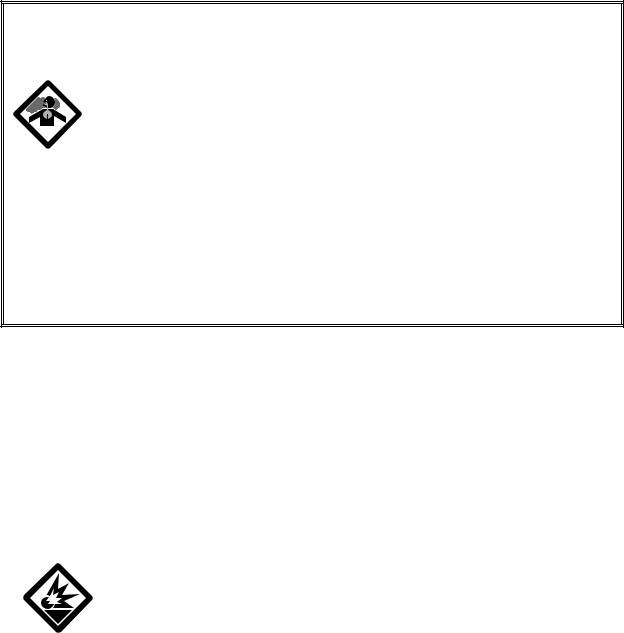
•Have a recognized specialist in Industrial Hygiene or Environmental Services check the operation and air quality and make recommendations for the specific welding or cutting situation.
Inhalation Hazard
Welding Produces TOXIC FUMES and GASSES.
Exposure to welding gasses can increase the risk of developing certain cancers, such as cancer of the larynx and lung cancer.
Also, some diseases that may be linked to exposure to welding gasses or fumes are:
• Early onset of Parkinson’s Disease |
• Heart Disease |
• Damage to the reproductive organs |
• Ulcers |
• Inflammation of the small intestine or stomach |
• Kidney damage |
• Respiratory diseases such as emphysema, bronchitis or pneumonia
Safety precautions, such as using natural or forced air ventilation and wearing a NIOSH-approved respirator, are ESSENTIAL to reduce the risk of developing the above illnesses.
12.Read and understand all instructions and safety precautions as outlined in the manufacturer’s manual for the material you will weld or cut.
13.Do not touch live electrical parts. Wear dry, insulating gloves. Do not touch electrode or conductor tong with bare hand. Do not wear wet or damaged gloves.
14.Protect yourself from electric shock. Do not use outdoors. Insulate yourself from the workpiece and ground. Use nonflammable, dry insulating material if possible, or use dry rubber mats, dry wood or plywood, or other dry insulating material big enough to cover your full area of contact with the work or ground.
15.Ensure that the unit is placed on a stable location before use. If this unit falls while plugged in, severe injury, electric shock, or fire may result.
16.Cylinders can explode when damaged:
•Never weld on a pressurized or a closed cylinder.
•Never lay a welding torch on a cylinder.
•Never allow a welding electrode to touch the cylinder.
•Keep cylinders away from any electrical circuits, including welding circuits.
•Keep protective cap in place over the valve except when the cylinder is in use.
•Use only correct gas shielding equipment designed specifically for the type of welding you will do. Maintain this equipment properly.
•Always protect gas cylinders from heat, being struck, physical damage, slag, flames, sparks, and arcs.
•Always use proper procedures to move cylinders.
SKU 93793 |
For technical questions, please call 1-800-444-3353; |
Page 8 |
|
Troubleshooting section at end of manual. |
|||
|
|
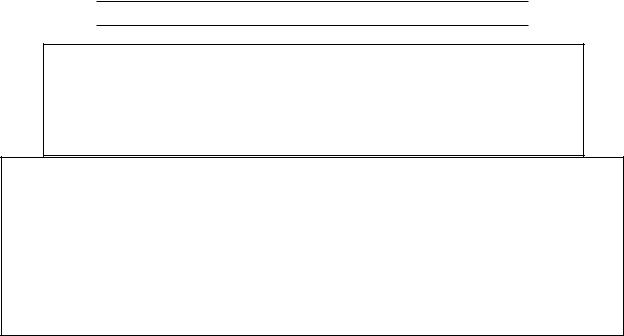
17.Use the right tool for the job. Do not attempt to force small equipment to do the work of larger industrial equipment. There are certain applications for which this
Welder was designed. It will do the job better and more safely at the rate for which it was intended. Do not modify this Welder, and do not use this Welder for a purpose for which it was not intended.
18. WARNING! People with pacemakers should consult their physician(s) before using this product. Electromagnetic fields in close proximity to a heart pacemaker could cause interference to or failure of the pacemaker.
WARNING! People with pacemakers should consult their physician(s) before using this product. Electromagnetic fields in close proximity to a heart pacemaker could cause interference to or failure of the pacemaker.
19. WARNING! The warnings and cautions discussed in this manual cannot cover all possible conditions and situations that may occur. It must be understood by the operator that common sense and caution are factors which cannot be built into this product, but must be supplied by the operator.
WARNING! The warnings and cautions discussed in this manual cannot cover all possible conditions and situations that may occur. It must be understood by the operator that common sense and caution are factors which cannot be built into this product, but must be supplied by the operator.
20. WARNING! This product, when used for welding and similar applications, produces chemicals known to the State of California to cause cancer and birth defects (or other reproductive harm).
WARNING! This product, when used for welding and similar applications, produces chemicals known to the State of California to cause cancer and birth defects (or other reproductive harm).
(California Health & Safety Code § 25249.5, et seq.)
SAVE THESE INSTRUCTIONS
GROUNDING
NOTE:
This Welder requires the installation of a 3-Prong, 220 VAC, polarized, twistlock Power Cord Plug (not included).
NEMA configuration # L6-30 or equivalent The Plug must be installed by a certified electrician.
 WARNING!
WARNING!
Improperly connecting the grounding wire can result in the risk of electric shock. Check with a qualified electrician if you are in doubt as to whether the outlet is properly grounded. Do not modify the power cord plug used with the tool. Never remove the grounding prong from the plug. Do not use the tool if the power cord or plug is damaged. If damaged, have it repaired by a service facility before use. If the plug will not fit the outlet, have a proper outlet installed by a qualified electrician.
GROUNDED TOOLS: TOOLS WITH THREE PRONG PLUGS
1.Tools marked with “Grounding Required” have a three wire cord and three prong grounding plug. The plug must be connected to a properly grounded outlet. If the tool should electrically malfunction or break down, grounding provides a low resistance path to carry electricity away from the user, reducing the risk of electric shock.
SKU 93793 |
For technical questions, please call 1-800-444-3353; |
Page 9 |
|
Troubleshooting section at end of manual. |
|||
|
|
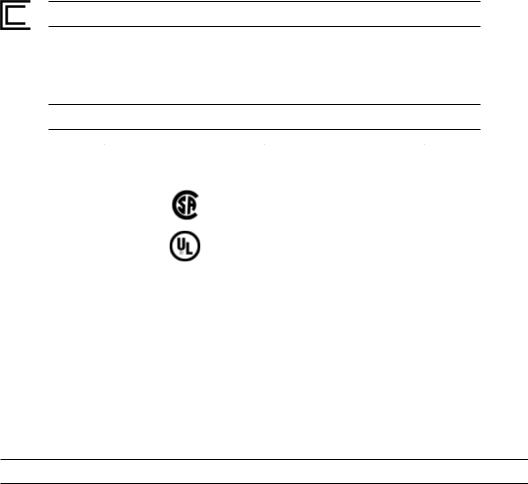
2.The grounding prong in the plug is connected through the green wire inside the cord to the grounding system in the tool. The green wire in the cord must be the only wire connected to the tool’s grounding system and must never be attached to an electrically “live” terminal.
3.Your tool must be plugged into an appropriate outlet, properly installed by a certified electrician and grounded in accordance with all codes and ordinances.
EXTENSION CORDS
AN EXTENSION CORD MUST NEVER BE USED WITH THIS ITEM. Use of an extension cord could result in damage to the item or fire.
SYMBOLOGY
|
Double Insulated |
|
|
|
|
|
Canadian Standards |
|
|
Association |
|
|
|
|
|
Underwriters Laboratories, |
|
|
Inc. |
|
|
|
|
V ~ |
Volts Alternating Current |
|
|
||
|
|
|
A |
Amperes |
|
|
||
|
|
|
noxxxx/min. |
No Load Revolutions per |
|
Minute (RPM) |
||
|
||
|
|
UNPACKING
When unpacking both boxes, check to make sure all the parts shown on the Parts Lists on pages 29 through 31 are included. If any parts are missing or broken, please call Harbor Freight Tools at the number shown on the cover of this manual as soon as possible.
SKU 93793 |
For technical questions, please call 1-800-444-3353; |
Page 10 |
|
Troubleshooting section at end of manual. |
|||
|
|
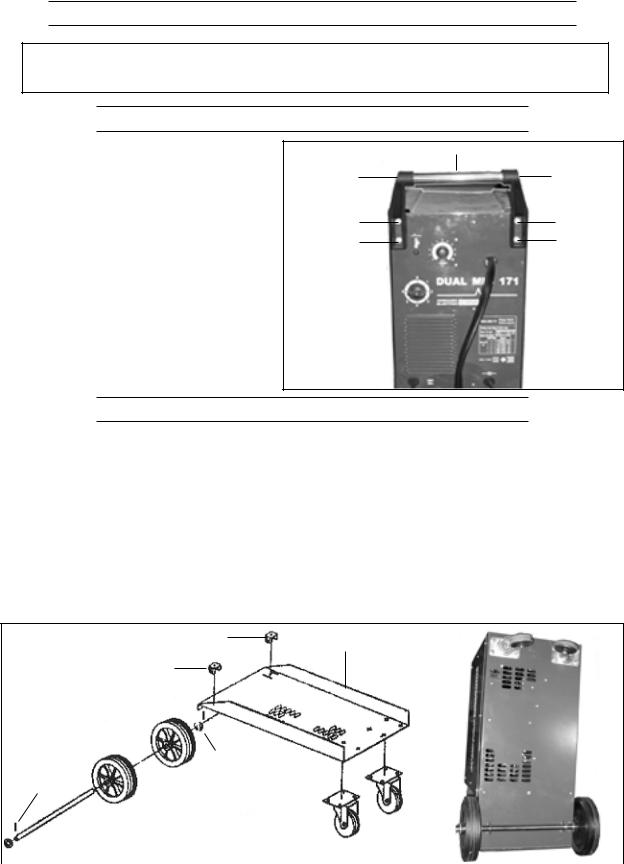
ASSEMBLY INSTRUCTIONS
 WARNING! Always turn off the Welder and unplug the unit from its electrical outlet prior to performing any assembly, maintenance, or service.
WARNING! Always turn off the Welder and unplug the unit from its electrical outlet prior to performing any assembly, maintenance, or service.
TO ATTACH THE HANDLE
Insert the Handle (45) into the Right Handle Socket (46) and Left Handle
Socket (58). Then attach the Right and
Left Handle Sockets to the Front Panel (57), using the four Bolts provided.
(See Figure A.)
HANDLE (45)
LEFT
HANDLE
SOCKET (46)
BOLT
BOLT
FIGURE A
RIGHT
HANDLE SOCKET (46)
BOLT
BOLT
TO INSTALL THE REAR WHEELS AND CASTERS
1.Insert the two Axle Brackets (40) into the slots located at the rear of the Bottom Panel (36). Secure the Axle Brackets to the Bottom Panel, using the two Screws provided. Insert the Axle (44) through the openings (located on the underside of the Bottom Panel) in the Axle Brackets. Insert one Wheel (43) on each end of the Axle.
Insert one Washer (42) on each end of the Axle. Then secure the two Wheels to the Axle, using one Cotter Pin (41) on each end of the Axle. (See Figure B.)
2.Align the four mounting holes in each of the two Casters (37) with the threaded mounting holes located at the front of the Bottom Panel (36). Then secure the two Casters to the Bottom Panel, using the eight Bolts provided. (See Figure B.)
AXLE BRACKET (40)
BOTTOM PANEL (36)
AXLE BRACKET (40)
|
|
|
|
|
COTTER PIN |
|
|
|
|
|
|
|
|
|
BOTTOM |
|
|
|||
|
|
|
|
|
|
|
|
|
||||||||||||
|
|
|
|
|
(41) |
|
|
|
|
|
|
|
|
|
|
VIEW |
|
|
||
|
|
|
|
|
|
|
|
|
|
|
WASHER (42) |
|
|
|
|
|
|
|||
|
COTTER PIN |
|
|
|
|
|
|
|
|
|
|
|
|
|
|
|
|
|||
(41) |
|
|
|
|
|
|
|
WHEEL (43) |
|
|
|
|
|
|
||||||
|
|
|
AXLE (44) |
|
|
|
|
|
|
|
|
|||||||||
|
|
|
|
|
|
|
|
|
CASTER (37) |
|
|
|
|
|
|
BOLT |
|
|
||
|
|
|
|
|
|
|
|
|
|
|
|
|
|
|
|
|
||||
|
|
|
|
WASHER (42) |
|
|
|
FIGURE B |
|
|
|
|
|
|
||||||
|
|
|
|
|
|
|
|
|
|
|
|
|
||||||||
|
|
|
|
|
|
|
|
|
|
|
|
|
|
|
|
|
||||
|
|
|
|
|
|
|
|
|
|
|
|
|
|
|
|
|
|
|
|
|
SKU 93793 |
|
For technical questions, please call 1-800-444-3353; |
Page 11 |
|||||||||||||||||
|
|
|
Troubleshooting section at end of manual. |
|||||||||||||||||
|
|
|
|
|
|
|
|
|
|
|||||||||||
